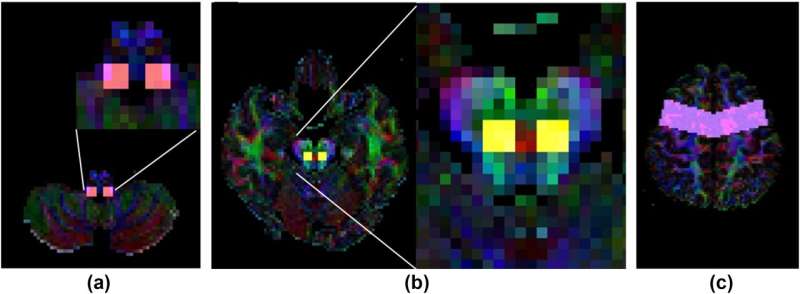This article has been reviewed according to Science X's editorial process and policies. Editors have highlighted the following attributes while ensuring the content's credibility:
fact-checked
trusted source
proofread
Research suggests answer to adolescent idiopathic scoliosis may reside in brain's corticoreticular pathway

Heavy school bags, poor posture, one-handed sports are often blamed for the development of curved spine in teens. Known as adolescent idiopathic scoliosis (AIS), it affects those aged 10 to 19 but has no known cause. A team from Singapore General Hospital (SGH) and National Neuroscience Institute (NNI) has now discovered that the answer to this condition may lie in the brain.
Employing a high-resolution and quality diffusion tensor imaging (DTI) brain MRI technique for brainstem tractography, the team found that patients with AIS had side-to-side differences in the corticoreticular pathway when compared against participants without AIS. This pathway links the brain's cortical motor areas and spinal cord and plays an important role in controlling one's posture and balance.
Associate Professor Reuben Soh, Senior Consultant, Department of Orthopaedic Surgery, SGH, and the study's first co-author, shares, "We see patients as young as 10 years old and oftentimes, parents have the misconception that it's bad habits or lifestyle factors that are the cause of scoliosis. We embarked on this study to try uncovering the real reason and in doing so, we hope to be able to better care for patients and support them and their families in managing the condition."
In the study of 34 participants completed in 2020, brain scans of those with AIS showed that the corticoreticular pathways connected to the right and left sides of the brainstem had asymmetric quantitative measurements. Their scans also showed an enlargement or swelling of pons in the brainstem, the bottom part of the brain linked to the spinal cord. In those without AIS, the pathways showed symmetric quantitative measurements, and the pons was not enlarged.
Professor Lo Yew Long, Senior Consultant in the Department of Neurology at NNI@SGH and senior author of the study, says, "This discovery suggests that scoliosis is fundamentally related to our brain and spinal cord. It could bring about changes in the way AIS is diagnosed or treated. For example, neurological interventions may potentially be employed to prevent the worsening of spine curvature. This could include the use of magnetic fields or low electrical currents to stimulate or modulate brain activity."
Symptoms of AIS include abnormal spine curvature, uneven shoulders, hips, and waist. The condition affects about 3 percent of all adolescents in Singapore, with the majority being female. SGH's scoliosis clinic sees about 300 cases each year. About 5 to 10 percent of patients have AIS severe enough that will require complex spine surgery, as it can cause nerve damage or breathing problems.
There is no cure, but in most cases, where the spine curvature is not severe and not at further risk of progression, patients are able to manage their condition with physiotherapy. The scoliosis clinic has a team of specially-trained physiotherapists to help these patients achieve improved mobility and muscular symmetry through exercise and core strengthening, which in turn helps to reduce the degree of spine curvature.
The study's corresponding author, Professor Chan Ling Ling, Senior Consultant, Department of Diagnostic Radiology and the newly formed Department of Neuroradiology, SGH, adds, "Looking ahead, we hope to conduct further studies on a larger cohort incorporating genomics, and using more advanced diffusion MRI modeling. This may enable us to potentially identify those at risk of developing AIS or AIS progression, or even understand why females are at higher risk of developing this condition."
The study is published in the journal Clinical Radiology.
More information: R.C.C. Soh et al, The hindbrain and cortico-reticular pathway in adolescent idiopathic scoliosis, Clinical Radiology (2024). DOI: 10.1016/j.crad.2024.01.027


















